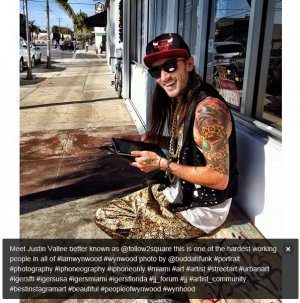Sheryo and The Yok talk about art, Miami and their “Endless Summer Travels“…
Sheryo and The Yok
How long have you been painting?
S: I started when I was 19 and the stopped in between where I wasn’t painting that many walls. After I met The Yok I painted a whole lot more.
Where are you from?
S: I am from Singapore originally but now we both live in New York.
Y: I am from Australia.
Did you come to Miami just for Art Basel Miami Beach?
S: Yes. We will be painting mostly. We are not fast about going to any fairs. We have a few pieces in a few gallery shows here in Miami right now. Brisky Gallery and Max Fish pop up and I am part of the exhibition “Women on the Walls” at Wynwood Walls with an entire line up of ladies who paint murals.
What themes do you explore in your murals?
S: We have been traveling a lot even though we are based in New York. We are kind of nomadic and keep traveling to different places so we take a lot of inspiration from things that happen during our vacations and travels. We are always looking for summer weather so we call it “The Endless Summer Travels.” Our murals are usually also inspired by a lot of creatures and characters on vacation. The second mural we painted in Wynwood is a creature wearing a holiday vacation shorts, on the beach, sun tanning, soaking up the Miami vibes. We try to keep it a bit site-specific.
Where are you off to next to soak up some more sun yourselves?
Probably Southeast Asia. Indonesia, Vietnam.
Do you usually get a lot of commissioned work at the places you visit or do you just go and find some walls?
It is a mix of everything. We have been pretty lucky so far. People see us painting a wall and then they like it and they approach us for another wall. Or through the internet.
You use a lot of gold in your work. What is the significance of that color choice?
S: We started using less colors because we were always traveling. A paint situation. It is just way easier to get the paint if you only use a few colors. We started to develop a style with just four colors. Our own little color palette.
Y: It is a trademark style. It is a lot bolder, the less colors you use and it heightens your line work because you have to be more focused on the lines. We use thick and thin line works to differentiate parts rather than color. I think the gold came from us working in Cambodia. They use a lot of gold leaf in their paintings and that really influenced us and stuck with us. On other travels, it is something that we have kept as a constant. It is a nice way to draw attention to a part of the mural.
Do you do murals and gallery work? Do you have any other upcoming exhibitions?
Yes, both. We have an upcoming show next year November in New York and in April in Australia.
You are from Australia. When did you leave?
Y: Maybe 10 years ago. I have been in New York for three years and before that I was in Bangkok and Kenya and Singapore.
Did you travel to all those countries to paint?
Y: I have a background in graphic design but my passion has always been painting. Every city we go to, we try and paint something.
You are both using an alias to paint. How did you come by your names?
S: He is The Yok and I am Sheryo.
Y: I just like the letters for mine. It has nice letters and it doesn’t have a meaning. My artwork gives it a meaning.
S. For me, it’s a combination of my real name and my obsession with Oreo cookies.
Was this your first trip to Miami during Art Basel?
Y: Yes, the first time. First time in Miami ever.
S: I wanna see some flamingoes.
What was the concept for the first mural you did in Wynwood?
S: The same thing really. Characters on a holiday, chasing the endless summer vibes. It’s got a bit of Miami flavor in it.
Tell us a bit about the gallery pieces you do
S: We are doing some stuff on batik. We have been doing our artwork on fabric done in the traditional batik way. It is totally new and on show at the “Women on the Walls” exhibit. It is a lot of work. If you do 10, maybe 5 or 6 come out nice.
Y: It is done with hot wax. You dye the fabric and then boil the wax off.
S: Last year we had a show in New York based on ceramics. We also did a crazy dragon sculpture on a skateboard that looks like it is made out of ceramics. We want to do more because it was so well received. We actually went to a village in Vietnam to do the ceramics. Same with the batik. We went there and did it. We spoke zero Vietnamese but we had so much fun with the locals. We did Karaoke.
What is your favorite Karaoke song?
S: Britney Spears
What do you listen to right now?
S: A lot of hip hop, rap and reggae lately.
RONE
How many years have you been coming to Miami during Art Basel?
This is the third year.
How long have you been doing murals?
I have been painting since 2001. I would say, on the streets since 2001. I was painting since I was a child really. I have been painting full time, as in I do not have a job anymore, for two and a half years. This is my full time job now.
Have you always painted women’s faces?
I always paint portraits. Not since I started but this is what I have become known for.
Do you know the women you paint?
I work from photo references. I work with a modeling agency. They cast the model and take the photos and have a make up artist to do the hair and make up.
Are they usually from Australia?
They are usually from Australia but sometimes from other places. Last year, I painted a girl from Quebec who happened to be in Australia. This girl I am painting today, she grew up in Australia but she is part German and part Maori.
Do they know about the murals? What do they say?
This girl, she was over the moon. She was so happy. To quote her, her mom “lost her shit” when she saw it.
How do you manage to capture the reflections of light, like in the eyes, and put in on a wall on such a large scale?
I build a grid to make a reference. I work from the grid to make sure all the proportions are perfect and then I just work from the photo reference and render it. What makes someone beautiful is that the proportions are perfect and they are very balanced. To paint a face that is kind of very expressive is easier and maybe an ugly, angry monster where everything can be distorted. In a sense it is a lot more fun to paint that. To paint something that has this perfect balance, it really has to be right.
You always have these paint drips coming down. Why are you using that specific technique?
It is just the way I have developed painting. I kind of like the aesthetic of the drips. It adds to the texture of the painting and it adds a micro detail to it. You can only see it when you are close but from far away you don’t really see the drips. It has an aspect of decay. I like the having something that’s really messy and raw contrasting with something that’s really beautiful.
Do you do gallery work as well?
Yes. I do a lot of gallery work. Same women but on canvas. I rarely make money from painting a wall. I make most of my income from selling works through galleries and releasing prints.
Do you have any forthcoming shows?
I am showing at Stolen Space Gallery in London next April. That will be my first show in 18 months. I might do a show in Melbourne. I have not done a show in Melbourne in over two years. I have been concentrating on doing stuff internationally.
What has your experience been coming to Miami during Art Basel?
It is funny, I just saw my friends who are here for the first time and they said “It’s so crazy here!” and I said “You have no idea! This is nothing. It has not even started yet!”
Are you planning to check out any of the fairs?
Yes I will be going to some of the fairs. Painting the walls is my priority but I try to get at least to SCOPE because I am showing some works there.
How did you come by the name Rone?
My name is Tyrone. It was shortened by my friends when I was 15. I never really did traditional graffiti, tagging my name or anything like that. It just became an obvious alias for me that I decided to use. I do not really do stuff illegally so I could go under my real name but I think Rone is more unique.
Where
were you born?
Saint Paul, Minnesota
What’s
your nationality?
American-Venezuelan; I was born in the U.S. and was raised in
Caracas.
How
long have you been in Miami?
Since 2001
What do
you love most about Miami?
It feels like home
How
would you describe your art?
Authentic, pure, sharp and tender, exquisite, elevated, velvety,
and lively.
Why did you start doing piñatas?
I found one piñata in a garage a long time ago and I thought it was very interesting. I just grabbed it. I always grab stuff that I find and then I store it for years. Then finally I started working on it. I had these bags and I put them over the face because I wanted to get rid of the face of the piñata. I was trying to see how it would look if you don’t see the expression. That’s how I started. I left it there. I just wanted to get rid of the expression. I attached the bag as if it was a final piece. Then I broke the arm and a leg to make it look funny and crazier. Then I left it there for two years. I was working on another show that I had to get ready. After I finished that show in Hollywood at The Art and Culture Center, I went back to working in the studio. I wasn’t working on any specific project. I started working with another two piñatas I found. I found them in Little Havana. I started working with them. I had it in my system. I covered the faces and stabbed them with sticks.
Why did you stab them?
Now, I am not interested in stabbing with sticks anymore, but at the time I was interested in destroying objects and stabbing objects to other objects. I broke the piñatas and the couches in the series I did before. It was spontaneous and aggressive and fast. It was something that I could not control. I just started destroying the object. To me, it was a beautiful object and I felt like the hard part is to get rid of it and destroy it and make it something else and forget what it was before and just let go. Forget what it was. Maybe it was trash and nobody used it and I made use of it. I destroy it. It is all spontaneous.
Do you keep the candy from the piñatas?
No, they are filled with newspaper. The one I found in Little Havana was filled with a really old newspaper in Spanish. I took it out and it was very interesting, even more interesting than candy. It has history and it shows how old the piece is and how unique. You usually buy a piñata empty. I know that because I had a party the other day for my son, so I had to buy a piñata for the first time. I was wondering about the candy and I had to add it.
You said you are not interested in destruction anymore. What is your current interest?
I am kind of the opposite now. My work is a lot about opposites. Actually, the title of an exhibit I had was “Outside In” instead of “Inside Out” because I started doing the opposite now. I started to assemble again instead of destroying. In a way, it looks more delicate, but there is always a touch of something sharp. It is a piece of glass or mirror or a stab stick or something like that or something sharp in another way, something a little aggressive and bold and spontaneous. Just in this case it is more delicate. I am not interested in just being aggressive anymore.
What are you working with for your current series?
Each series takes a year to develop and finish, more or less. I worked through the couches and the piñatas and now I am working with mirrors and assemblages with jars. I am going back to the glitter and back to reflections.
When you find the objects you use, does it matter to you where they come from?
It matters. It gives a lot of energy to it. It is not the same if you buy it than if you find it. It looks more natural and real when you make the composition or installation. If you buy it, it’s even harder to make an installation. I got the jars from using room service. I went to Copenhagen, Denmark and I started collecting all these little jars from the room service, with the jelly. I put them in my suitcase and brought them to Miami. I cleaned them and put the jelly in a Ziploc bag. I didn’t want to throw it away. I used the honey, I used everything, of course, it’s from Europe. So I cleaned them and took off the tags. They have their value. They are beautiful, cute and so adorable. I never usually buy anything unless I have a solo show and I need to add something. I have been accumulating jars for years. It is all part of the experience. These are all for a solo show next year. I just started working on it. I have these diamonds, not real diamonds, that I found. I took them off some old jewelry. I am still destroying objects like my old jewelry. Then I found these flowers in Lugano, Switzerland. I took them from a garden and I was so scared that someone would come and tell me I cannot take them. I did not know how people would react. The garden was so beautiful. I take advantage when I travel to pick up pieces for my work. It inspires me. I love it. I also have jars from Japan. Sometimes I leave the labels if I think they are interesting in a way and in some cases I leave them empty. Straight to the point of the jar. I am getting more to the point now without all the destroying and assembling. I do not know what’s going on with me.
Is your work predominantly an emotional expression or a thought out concept?
I never overthink anything. I think of it all the time so I have it in my system and it can stay with me for a long time. I have been accumulating these little jars for years and years but finally now I can start working with them and do what has been in my head all this time. The ideas are something I want to do. When I am making them, it is very fast. The thought process takes more time than when I actually take them and start playing with it. It is a very personal experience, like I am a little girl making stuff. What makes me more peaceful in my mind is that, after accumulating all these objects, now I am at a point where I ask myself what makes these objects interesting. So, I am just showing the object instead of making the whole assemblage or destroying it. I am just showing the actual miniature glass and that’s it.
How do you title your work?
The titles have nothing to do with the piece. I have one called “You Won’t Here” and one called “I’m Unavailable” or “The Best.” It has nothing to do with what you see. It’s just an abstract title related to something that was happening during the time when I made it. It actually reminds me of that time. The title and the piece capture a moment.
You use a lot of yellow. What’s the significance of the color?
It might sound crazy but I feel the colors. One time, I felt red so I was very obsessed with red. I still use red but three years ago I started with yellow and black together. I was obsessed with black and yellow, or yellow and black, because they look very aggressive together. They also kind of represent poison or a warning or alertness. They are attractive but at the same time they are dangerous in a way. The contrast of yellow and black is very strong. Now, that I am not into being aggressive as much I still use the yellow and I still use black but they look more beautiful. I am now trying to change the aggressiveness into something beautiful and dreamy and surreal. Making the opposite.
Please tell us about your forthcoming jewelry collaboration.
It was inspired mainly by the piñatas series that I did a year ago. The jewelry designer of Espiritutara came to the show and thought it was cool and she wanted to work with me on a collaboration and I loved the idea. I thought it may take my art to another level that I cannot even imagine. Who knows what‘s going to happen? I always take opportunities that sound like fun. We started working on it and it took a year and now it is ready. We have piñata pieces and these solid metal pieces with the piñata eyes. The other part of the collection is more about the textures and the colors black and yellow with a touch of red. I have the little pom poms and little sparkles here and there. I always add a touch of something that shows reflection. It will be available for Miami Art Week/ Art Basel for the first time at Primary Projects.
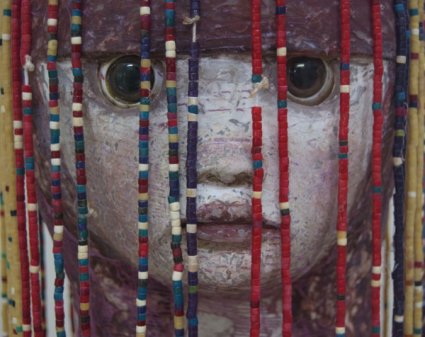
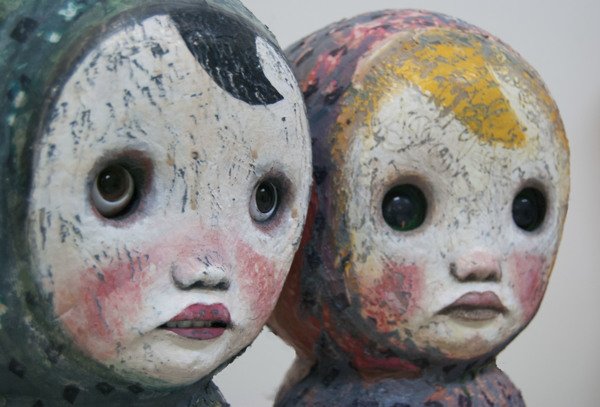
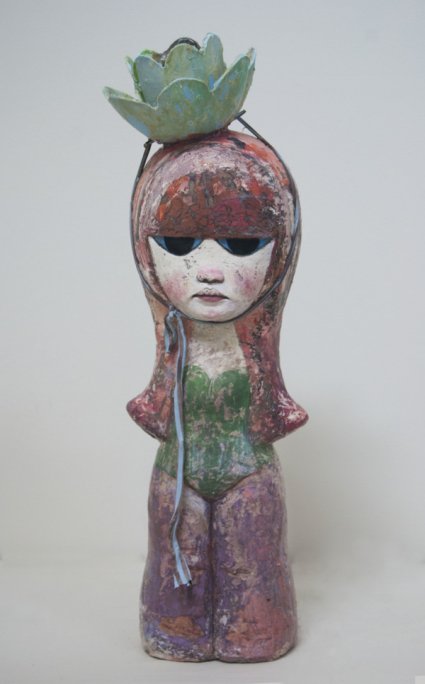
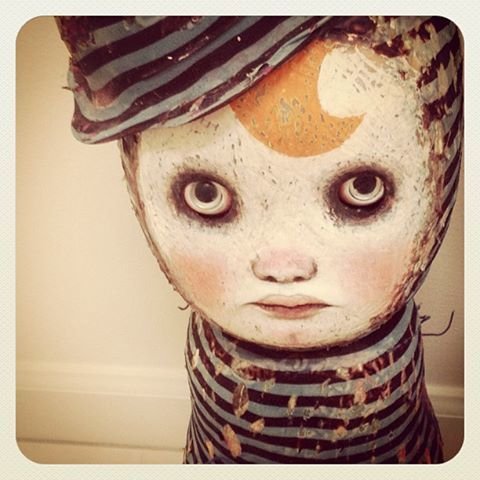
When
did you start making sculptures?
I have been doing art since my childhood, but it was in 1998
when I started this doll theme. I began with a group of small statuettes with
plaster, clay, natural hair and fibers. My idea was to create these “idols” from
a lost civilization, an object taken from an ancient burial, but with
contemporary or even futuristic references. A collage of different cultures and
times.

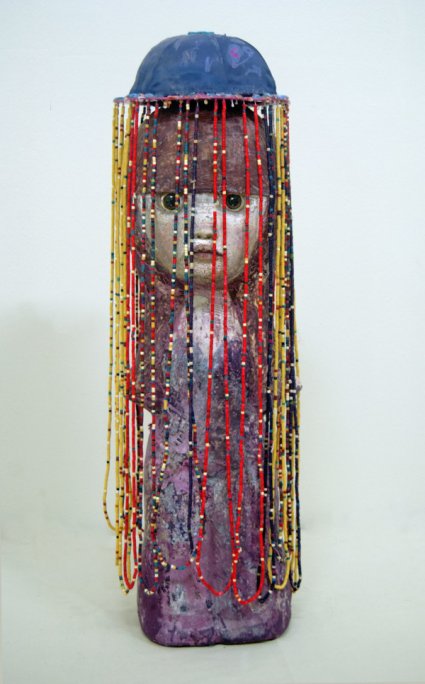
What
is your fascination with dolls?
It is a fascination I had ever since I can remember. It is hard
to explain why I chose the doll as my inspiration. I guess I am attracted to the idea of working
with the human figure as an object, an artifact.
Do
you create a story around each individual doll or an individual identity for
each?
They usually come in a series. I have an idea to start with, a
story or a “script” as if they were characters from a theater play, and in the
process of making them, the initial concept evolves itself often opening
unexpected paths of creation and interpretation.
What
is your creative process from idea to final sculpture?
It’s very routinely, as a matter of fact. Frst is the
inspiration, some sort of “current obsession” that can be anything from ancient
cultures to mass media and pop culture. I start intensive and rather visual
research. Once I have a good bank of images and references I start to put them
into sculpture. It’s a very long process that evolves organically, flowing
within its own energy.
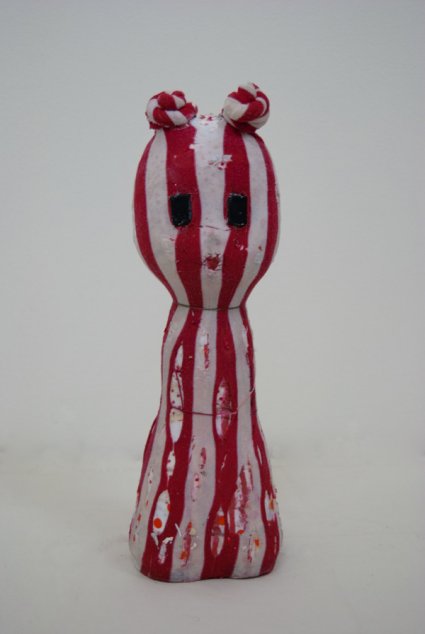
Your
sculptures juxtapose young and old and beauty and imperfection which infuses
depth and character. What inspires your creations?
My sculptures are about expression rather than a search of
perfection.. That’s the beauty of it. Every piece is made by me from scratch trying
with all my heart to make them meaningful, to me at least. My idea is to create
fictional characters but with human expressions. I guess they are a very
personal and intuitive interpretation of the human psyche. It takes a lot of
work to achieve that point when the piece “vibrates” and starts dialoguing with
the spectator. That process does not have anything to do with technical
perfection.
Your
doll sculptures evoke a slightly haunted feeling. Is that intentional?
They come out a little creepy, but that is not necessarily intentional.
Do
you collect dolls?
Yes, I love collecting dolls. I have a little collection from
the places I visit. Like with my sculptures, there’s a story in each and every
one.
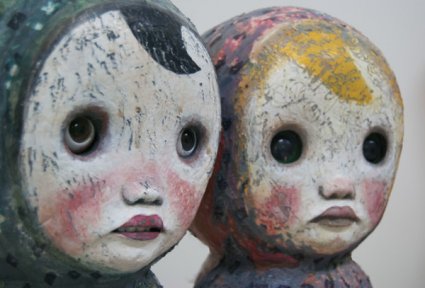
Your
current series is entitled “Traveling Circus.” What aspect of the circus
inspired you?
My dad introduced to me the 1930 film “Freaks” by the director Tod Browning, I
always loved that film. It is a heartbreaking story of the dramas within a
traveling circus. One of the facts that I always find especially touching is
that several of the film’s actors are handicapped people, some with massive
physical deformities. They make the film even more powerful and heartbreaking. In
my new pieces I try to portrait that “other side” of the circus world, often
obscure and full of sadness and drama.
Did
you think of characteristics of clowns and harlequins?
For me the clown has multiple meanings. It is happy and scary at
the same time. I am sure most kids can agree. They are masks, representations
of human feelings, but in such an exaggerated way that the results are almost
violent.
Tell
us about your group show “Nuevas Fundaciones” with Kiki Valdes and Jel
Martinez.
Kiki Valdes, artist and curator of the show, had the idea of
making a show with us three. It has been an awesome experience. We might have completely
different ways of expression, but ultimately, we work with the same ideas such
as pop culture, mass media and street art.
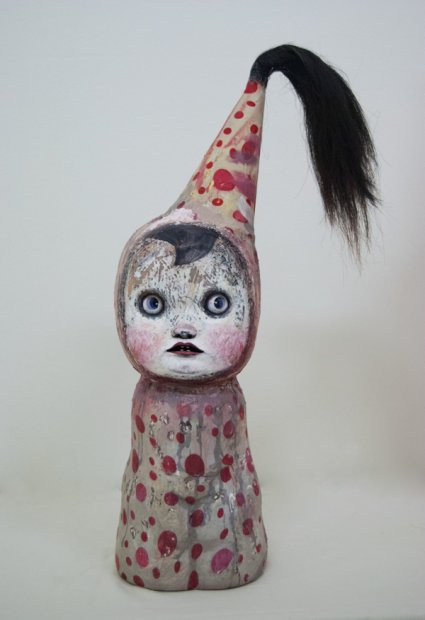
What
are you working on next?
I am taking a good rest for now thank you. However, when I start
feeling the “empty nest” for a couple of months, my mind starts to be fertile
again for a new “current obsession” and a new family of sculptures begins to
grow.
What
medium would you still want to experiment with and why?
I suppose the logic next step for me is starting to think about
my pieces as prototypes and then make pieces in other materials such as vinyl
or giant inflatable figures.
What
do you enjoy most about the life of an artist?
Having your own schedule and having the satisfaction to receive
nice words from the people you care about after many months of studio loneliness.
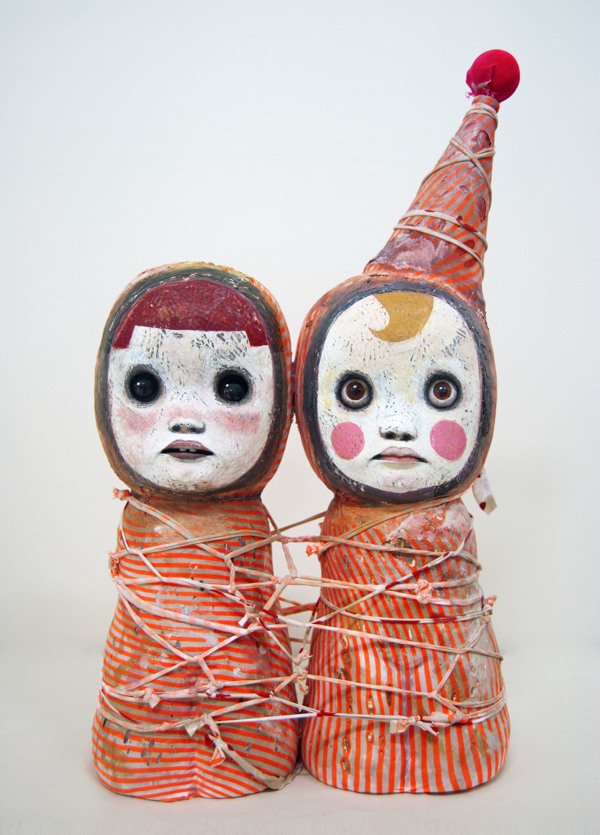
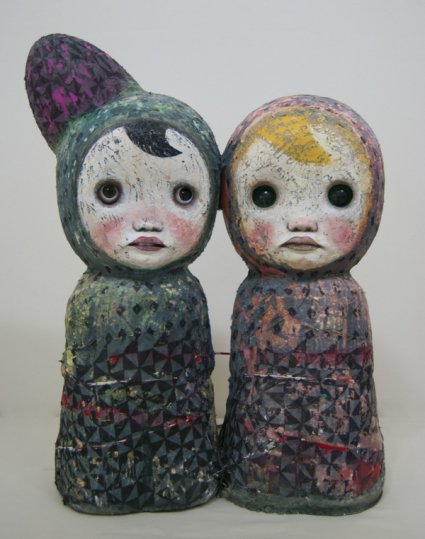
What
challenges are the hardest to overcome in forging a successful career?
You MUST have a structured routine in order to achieve
something, that’s the key for a productive art career. The work begins,
evolves, matures in the making, there’s no other way.
Can
you share something personal about you that people might not know?
I am an obsessive person, sometimes I get stuck in an idea and
cost me a lot of effort to get out of it. I am beyond stubborn.
What
songs are you currently listening to?
I am definitely into electronic music. I need something with a
beat to make my body move. But, I can easily go from the most aggressive
dubstep to baroque music, it depends on the mood.
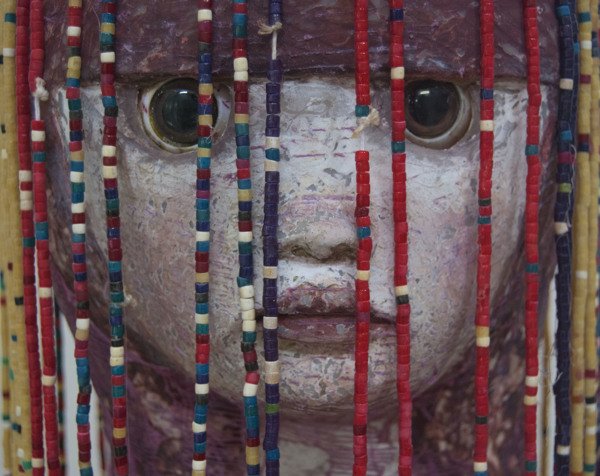
Have
you ever made a sculpture based on yourself?
A couple. I used to take photos of my face as reference for the
pieces, as if it was just another work tool.
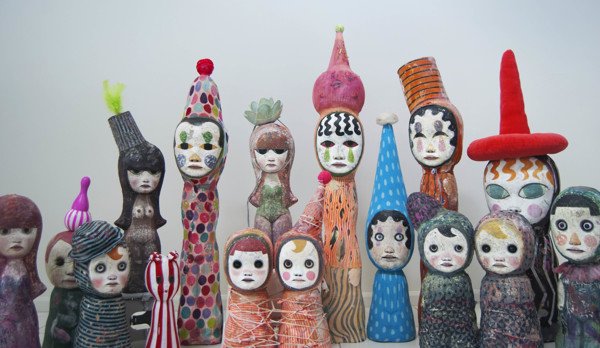
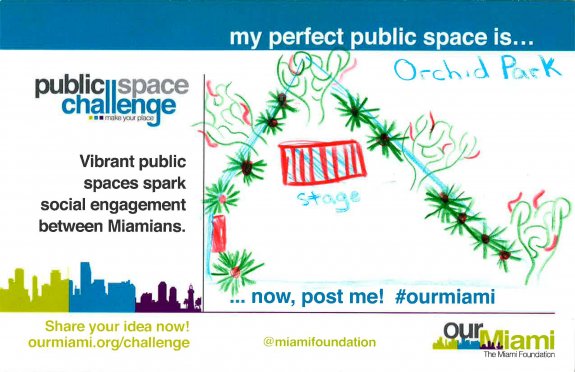
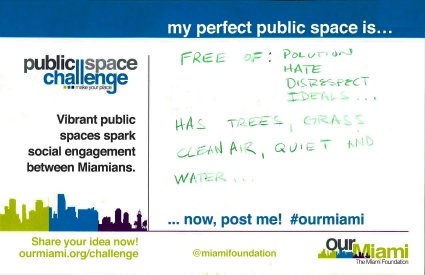

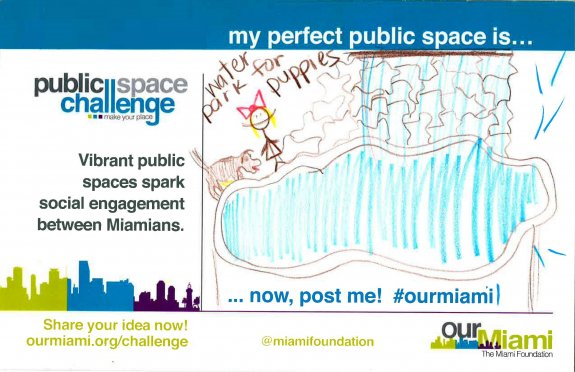
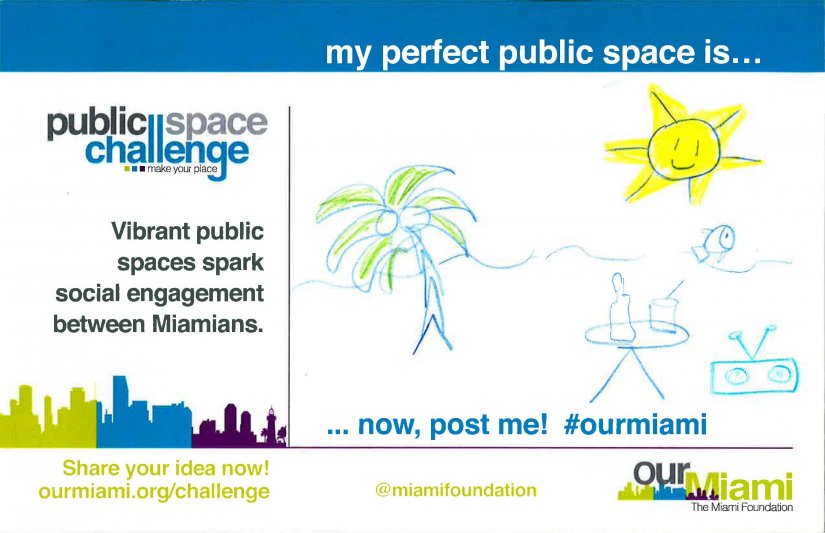
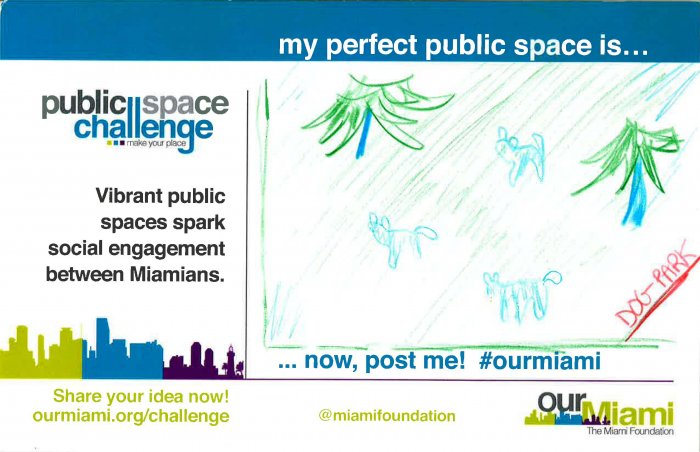
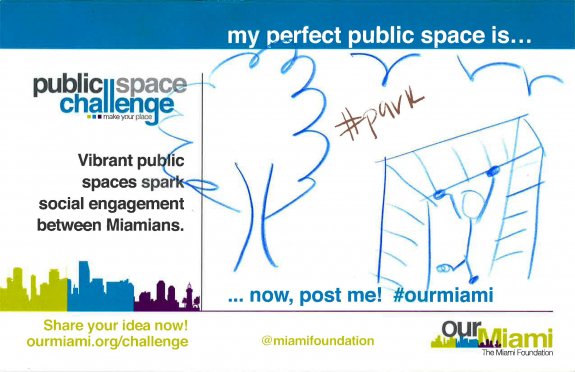
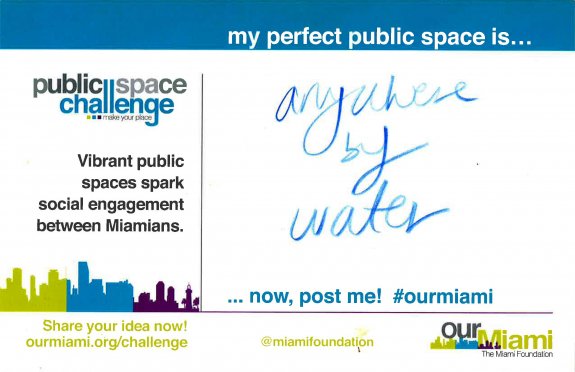
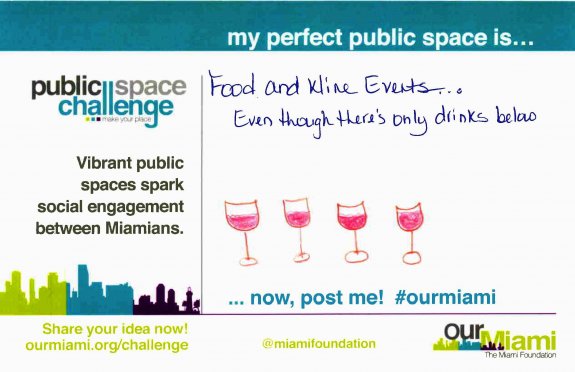
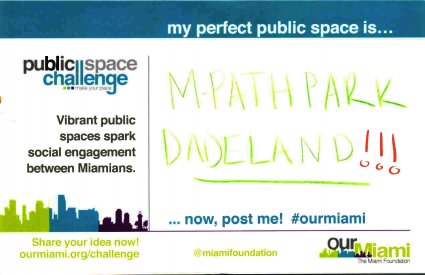
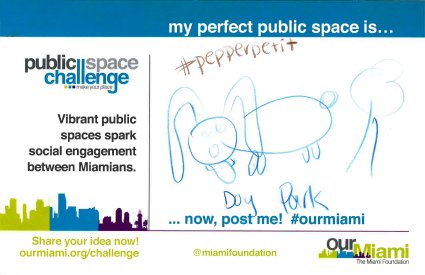
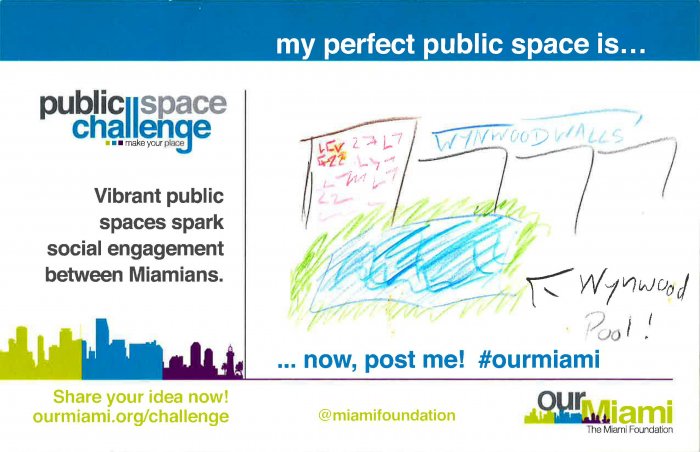
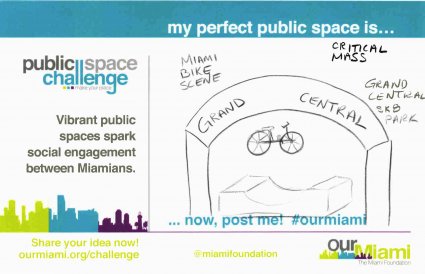
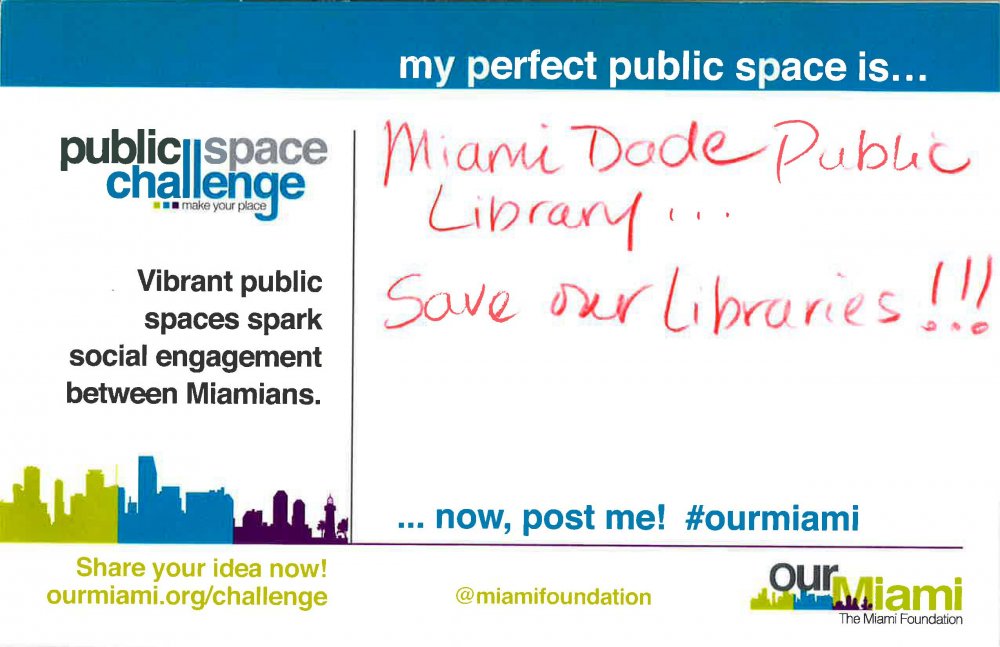
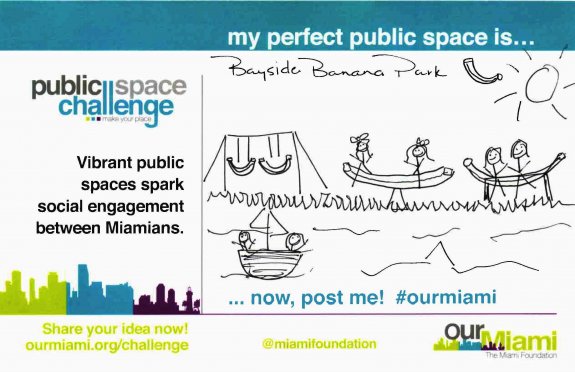
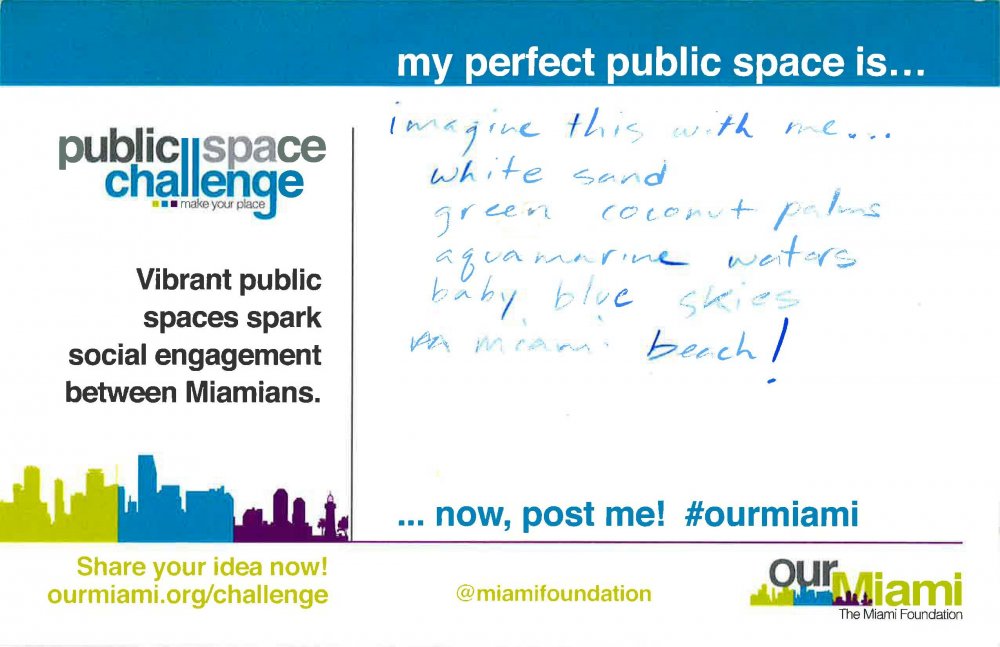
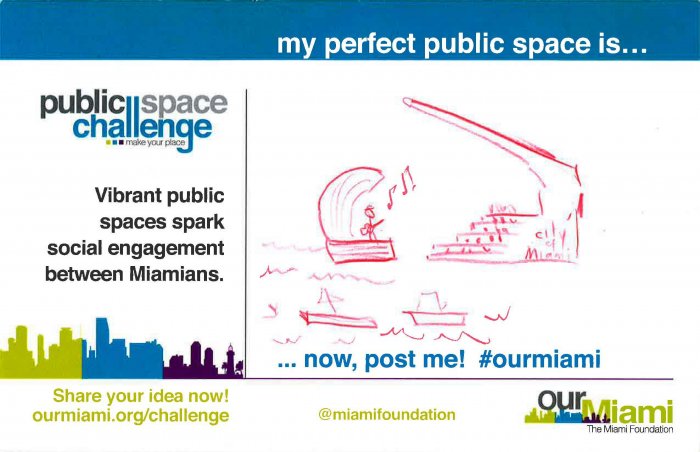
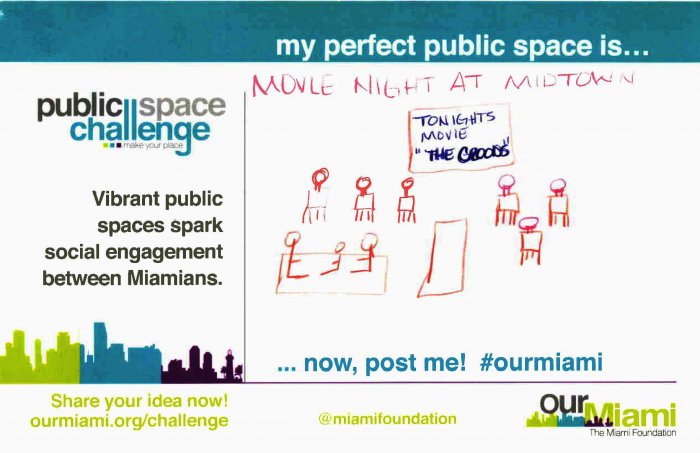
“Backyard Paradise” at Swampspace combined art and a backyard outing with friends into a great night of fun on Friday, September 13th, 2013.
What could be better than an exhibition of some of Miami’s best artists, giant soap bubbles, battered and fried alligator personally caught by the curator and slices of fresh pineapple and watermelon all on one evening? Nothing! It was a perfect summer night in the 305.
Curated by Johnny Laderer, the exhibit featured works by Dogan Arslanoglu, Bhakti Baxter, Justin Cooper, Giles Neale, Gustavo Oviedo, Johnny Robles, Rachel Rossin and
George Sanchez Calderon.
Swampspace announced:
We are nonchalant when presenting “Backyard Paradise.”
When we say “leisure,” we mean “quality of life.” We mean BBQs and sports—relaxation, because Everybody’s working for the weekend. After WWII, when the American economy boomed, tract housing erupted in sprawls of demi-castles, each with its very own back yard. At the same time, the beginning of the twentieth century saw work-week hours reduced from 60.1 to 47 hours per week. The world of work is intimately linked to our time for contemplation and observation; and for an appreciation of the psychology of space.
Today, however, Americans work more than any other industrialized nation. We enjoy far less leisure time.
Situationist International identified leisure in a capitalist society as illusory; not free time, but rather a commodity sold back to the individual. Compartmentalizing lives is a farce. Constant work, society is convinced, creates to more time for leisure.
Time available for leisure varies from one society to the next, although anthropologists have found that early man and hunter-gatherer societies had significantly more leisure time than people in more complex (modern) societies. Europeans on arrival to America saw natives as lazy. Today American society has taken it one step further with increasingly less time for leisure than their European counterparts.
In many ways, the backyard and leisure go hand-in-hand to the point of interchangeability.
Functioning as spaces for more personalized and often kitschy expressions of an idealized paradise, the manicured façade for the world in the front yard occasions private expression in the backyard, or, as they say: “Business in the front, party in the back.”
Backyard Paradise presents artists whose lives and work seem to blend seamlessly.
Whatever their passions or interpretations of leisure may be, their efforts to live life holistically are reflected herein. Their work examines the relationship between the backyard and everything that might appear on a postcard: sailing, reading, gardening, fishing, BBQing, surfing, golfing, swimming, sunbathing, playing tennis, or swinging in a hammock. “You visit; we live it!”
Guccivuitton presented Hugo Montoya's second solo exhibition in Miami, “Cause living just isn't enough,” an exhibition consisting of four new artworks that evoke marginally concealed social tensions through their menacing monumental physicality. True to Montoya's past endeavors each of these works exists in a contradicting space that is both flippant and earnest, while demanding a performative confrontation with their audience.
Stolen Boulder, a 300 lb concrete cast boulder suspended on a thin steel rod, which is formally and pragmatically Sisyphean, recalls Ovid's tale of Ephyra's infamous king's respite during Orpheus' song to Eurydice. The suspended boulder, pitting man's engineering against the natural law of gravity, and the seemingly inadequate rod, like Orpheus unavailing song, propose the troubling inevitability that eventually and rightfully the rock will come crashing down to the floor beneath it. The end result provides an astoundingly implausible tension that invites closer observation as well as instinctually activates the desire to flee.
Clay excavated from deposits in a previous Jim Crow era "colored-only" beach on Virginia Key slathered over a thin monolith-like wall harkening the artifacts in Stanley Kubrick's, "2001: A Space Odyssey", constitute the piece, Black Beach. Like the artifact from 2001, the piece acts as a silent specter to an early experiment that lead to a paradigm shift in Miami's racial narrative. The deeply pitted and cracked pachyderm-like surface of the dried clay offers an emotive insight into the sentiment of 1945 when civil rights activists staged a "wade-in" at the white's only Baker's Haulover Beach which eventually led to the establishment of a "colored-only" area.
While Montoya's work broaches the darkness of contemporary life, his playful and creative insight and mischievous approach to materiality quenches our appetites for hopeful avenues and options to everyday situations. In a way, artists like Montoya propose that art and wit, above politically complicated best-intentioned solutions, offer the more generous possibility of a humane and progressive outlook.
The Collabo Show - Back by Popular Demand
“The Collabo Show” was “Back by Popular Demand” for one night only in a warehouse space in Wynwood. Part of a series of one day exhibitions dedicated to collaborative engagements among artists “The Collabo” featured more than 100 Miami-based artists like Bhakti Baxter, Agustina Woodgate, Johnny Robles, Sinisa Kukec, Onajide Shabaka, Franky Cruz, Gustavo Oviedo, Magnus Sodamin, David Rohn and Hugo Montoya.
The forth installment of the artist-run exhibitions that began in 2005 brought together artists with a wide range of practices. Engaging, interactive and experimental the art in “The Collabo” was all about enjoying art for art’s sake. The audience was invited to participate and immerse themselves and essentially become collaborators in creating a truly artistic, creative and self-exploratory experience.
Originally conceived after spontaneous collaborations at dinner parties the event always takes place in the middle of the blistering Miami summer hosted in a different space each time. Selected artists are encouraged to challenge their individual practices and enter a realm of co-experimentation. As a result, the majority of the works have been performative and interactive in nature, culminating into a vibrant and jovial happening.
The art engaged and involved the viewer on different levels. Some pieces were very personal, solitary experiences that fostered a one-on-one interaction between art and viewer, whilst other pieces were geared towards interactive, shared group experiences.
Sodamin’s project “Illuminations” aimed to explore a collaboration between painting performance, light and sound. Painted dancers Katie Stirman and Jenna Balfe were immersed in a large-scale Day-Glo painted background through movement and interaction with each other to the sound of echoing guitar loops. Movements were minimal as the dancers responded to each others gestures, never physically touching yet connected in movement and spirit. Says Sodamin, “Through patterns of repetition the piece brings focus on mimicry in nature and the animal instinct to change and adapt to the environment.” He adds, “As the large rorschach patterns in the background seem to reference spinal or pelvic areas, the dancers float the idea of their personal space and structure. Both, innocent and daring, the piece years to call to a primal past from which man has emerged..”
"Ive been trying to reverse the state of childhood into adulthood with some of my works. Also attempting to retrace ambiguous memories or feelings of my childhood and my fascination with science and nature. It starts out with daydreaming, which most adults don’t do anymore, instead play in there minds. I thought it would be appropriate to create something where people can play out loud for others as well for themselves to experience.”
The most popular piece of the night was a collaboration between Johnny Robles, Giancarlo Sardone and John McMahon. Paint-filled balloons were attached to a large-scale canvas and the anticipating crowd people was asked to use a slingshot to fire marble rocks at the balloons and thereby release the paint and be part of the creation of an abstract rainbow-colored painting entitled “Recreation Paint.” The artists encourage active engagement by the viewers, who each leave their mark
Explains Robles, “The soul of ‘Recreation Paint’ resides in its psychological implications: the piece presents itself to viewers with no pretensions. It is a work that needs no plaque to explain its intentions, they become obvious when the viewer's gaze drifts downward where they find laying at their feet a bag of marble pebbles and a bin of white slingshots. Pairing this nostalgic set of tools with the image of paint filled balloons, whose pattern is reminiscent of thermal imaging scans, the viewer concludes that their role is greater than that of mere spectator: they can shape what the piece becomes.”
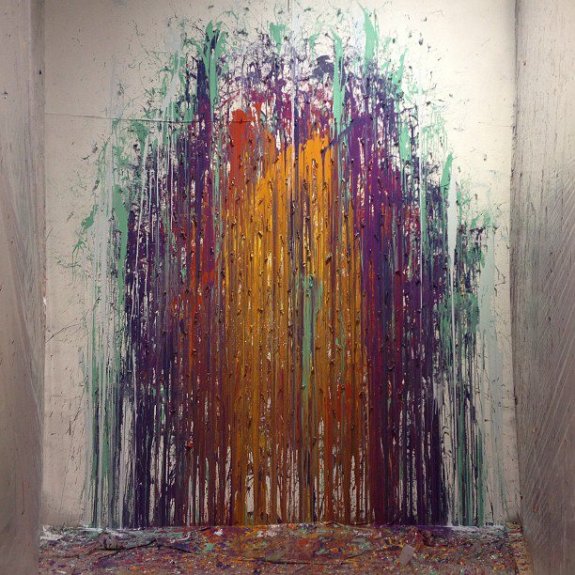
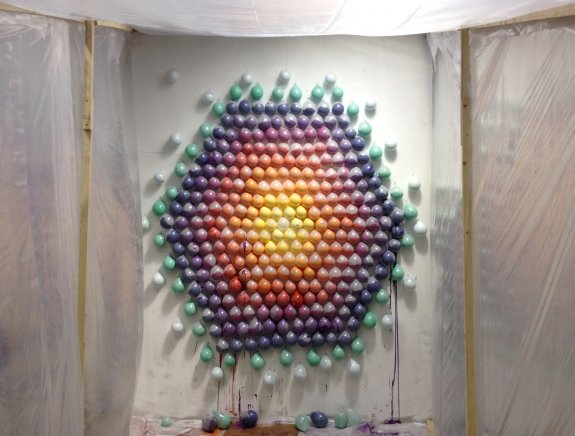
Gutierrez originally collaborated with Angelica Vergel, who is getting her masters in Media Studies at the New School in NYC. Gutierrez made a playlist on Spotify titled "Work" with songs that were titled "Work," "Werk," "Werq," "Werqing," and even "Professional." All songs, mere images of effort, are a call to "work" or reference expectations of someone else "working." Vergel made a YouTube playlist titled "WORK" and found similar video clips from all these random and crazy sources.
Things had to adjust once the artists started to set up for the show which brought forth new collaborative efforts. Explains Gutierrez, “When I set up the computer on a plinth in the space for the show, the computer was too old to play Spotify and the video link wasn't working so I asked Amanda Sanfilippo from Locust Projects how I could do something online with the computer with her and we decided to go onto the website: http://www.twoyoutubevideosandamotherfuckingcrossfader.com/ I convinced the band playing next to me to let me use their audio system when they finished their set and hooked up the computer to that.”
Taking the theme of the show to the audience Gutierrez invited everyone to participate and collaborate with him by picking songs to play and let creativity run free.
Franky Cruz’ and Mauricio Gonzalez’ installation centered around the song “Unicornio Azul” by Silvio Rodriguez, which Cruz calls a “romantic, epic, sentimental, sad song.” The old Cuban song’s beauty stands in sharp contrast to the aesthetically unappealing foam piece “smoking” a Cuban cigar while being observed by a surveillance camera. Whether an ode to a woman or to art, the collaboration invited viewers to simply enjoy music, muse over the meaning of art in their lives or take their interpretation further and discuss migration and government policies.
David Rohn was part of a attention-grabbing, obnoxious-on-purpose and in-your-face troupe of performance artists based in and around a white tent inside the warehouse. The performance, involving drag queens, clowns and divas, was an entertaining exploration of presence, personal space, social class, American society structure and narcissism, especially in the age of social media. Inhabiting their own space within the tent, an exclusive space for a selected view, the performers made relevant statements asking the audience to think about a culture that creates “elites, “ whether the rich and powerful, politically influential or celebrities.
The “Closed Circuit” performance combined fun and serious ideas into a captivating performance as the audience observed a VIP party in the tent with champagne, cake and music. Only few were invited but you can check out the photos on Facebook and Instagram later to see what an awesome party you missed because you weren’t on the list. The divas love themselves and took a lot of photos while you had to dust the flour and cake crumbs off your clothes and wipe the smashed grapes off your shoes.
Hedges collaborated with Kevin Arrow for the third time, turning their initial idea into a series. The first collaboration was “Breakfast,” followed by “Lunch” and now “Dinner” for the latest edition of “The Collabo.”
Says Hedges, “It has always been a dry documentation of something I regularly prepare and consume. I am the one cooking and Kevin shoots it. This time I made chicken tacos which I probably make once a week these days.”
Arrow adds “We have collaborated previously on these wryly, humorous didactic film-strip presentations. ‘Breakfast’ was created in 2005 for the Co Operate exhibition at Bas Fisher Invitational. The second one, ‘Lunch’ was created in 2007 for the Confluence exhibition at Fredric Snitzer Gallery.”
In line with Hedges’ food-centric oeuvre he will team up with Arrow again to serve the next two courses of the series, “Dessert” and “Midnight Snack.”
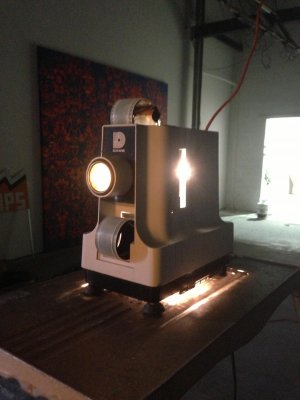
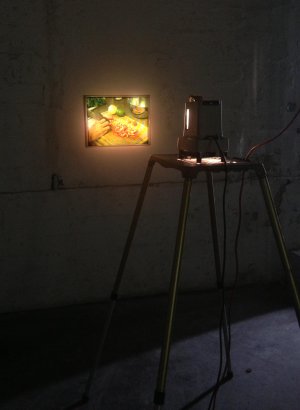
Where are you from?
I grew up in New Mexico in my formative years. I kind
of lived everywhere though. I went to 16 different schools before I graduated
from high school. I did move around a lot. I have been in Miami for about eight
years now.
What brought you to Miami?
Definitely the culture and the ocean. When I came to
visit my parents, who live on the other coast of Florida, I came over to this
side and just fell in love with the ocean. I actually lived in Coco Beach
before I came here. I love to surf and they have good kite-surfing. In Miami
not so much but I can go to California and surf. I go snorkeling every weekend
cause I love the water here. It’s amazing. Growing up in the desert it’s is
totally different.
When did you start your career as an artist?
That’s always a hard question to answer. Generally, I have
been painting ever since I can remember. Professionally, it has been about
eleven years that I have been working on my art and doing contract work and
painting for galleries. The last two years is when I really made the commitment
to do it full time.
How does your moving and traveling change or influence your art?
It definitely adds a lot of color. I always had really
colorful work but here in Miami my work is almost neon, it is so colorful right
now. I am completely influences by the colors here. I am just a very vibrant
person as it is.
Your subjects are mostly women. Why?
My stuff with the ladies is definitely more popular. I
really love doing portrait style work. I did photo-realism for a long time and
I did a lot of black and white portraits of people. I also did black and white
photography. I love drawing old people. I hate drawing kids. I cannot do it.
Their heads are shaped weird. I am just not familiar with little children. I
love those imperfections that make people so beautiful.
Do you base the characters on women you know?
Sometimes it’s people that I know and then a lot of
times it is just on top of my head and just let it go.
Are the ones with the glasses based on you?
The ones with the glasses are based on me. Actually, I
was listening to a lot of No Doubt, so there is a lot of Gwen Stefani in it but
I also put me in it. I don’t really like doing self-portraits and adding myself
into my artwork so it is more about hints. A little tattoo here, or the glasses
there, or some kind of fashion element that I like.
You are very interested in fashion. Can you tell us more about how you
incorporate that into your art?
For a long time I wanted to do fashion illustration. I
am really good at drawing females. I love creating new outfits, especially
accessories and headpieces. I make a lot of jewelry. I used to paint on pieces
and make earrings. I really like making headdresses. It is my favorite thing.
It is something I have been wanting to explore more now cause I haven’t done it
in a long time. I spent a good four years making my own outfits. I used to be a
party kid and did the whole dance lifestyle. I do not know what you call them
here but in Colorado they used to call them “Candy-Stripers.” We would go to a
party and get the party started by getting everybody to dance. We would go on
the dance floor and get everyone excited. I did that a lot. I would make new
outfits every weekend. A lot of people wanted to buy my stuff so I started
making clothes for other people and started designing my own stuff. I haven’t
done it in a while. My sewing machine is nicely tucked away.
You have many Native American references in your work. Where does that
influence come from?
There is a lot of Native American influence of course
in New Mexico and I am also part Shawnee, which is actually from the Midwest. The
Ohio basin. I have a little bit in me. I have done a lot of research into all
the tribes of North America and also South America. I am into Asian tribes
right now. They have these amazing headpieces that they wear. I really like
history. I read up on Shawnee culture and I know pretty much everything about
their history that there is to know. I read as many books as I could find. It
is really beautiful how their cultures are so similar but so different at the
same time.
Do you keep the meaning behind different aspects you use in your work
in mind?
I do. For example, some of the patterns that you find
in tribal designs have specific meanings, like three solid triangles in a row
can be clouds. When you have the different shapes and different line work and
when I put it in my artwork I do it for a specific reason. Usually, I am trying
to tell a story in a non-verbal way, using patterns and imagery, which is why I
have been doing a lot of pattern work in my pieces recently.
What are you currently working on?
I am working on a bunch of pieces for a solo show this
fall. It will be my first solo show in three years. I have not actually put
together a body of work to show all on my own so it’s very nerve wrecking and I
am very nervous to out my work out like that but I think it is a good, natural
progression for an artist.
Have you decided on a theme for the show?
Yes. It is called “Inner Reflections,” which is based
on one of my pieces of a girl that has a reflection of herself behind her. She
is very peaceful and tranquil and then behind her is this angry person but its
all rainbow. The light is coming out of her even though she is not expressing
it. Above her is a bunch of elements from my past like I lizard that I had when
I was a kid and my mom’s favorite flowers and my grandma always loved
butterflies so I have butterflies on there. The date for the show is still kind
of up in the air. It is either going to open on the second Saturday of October
or November. Most likely it is going to be November at Unix Gallery in Wynwood.
You also often paint tigers. What’s the story behind the tiger?
I always had a really strong connection to really
large cats. They are really smart. I do like small cats, too, but I am not as
impressed with them as I am with large cats. Some can be so individual and
others are extreme pack animals. Or they can be both. They are just very
independent, which I think I vibe with.
Did you start with canvas or murals first?
Murals. I actually started painting murals with paint
and then moved into acrylic. I did a lot of graffiti in high school. Once I
decided to take a move in another direction I started doing my murals in spray
paint. Now, I mix it up. I do paints and markers. I have been doing a lot of
murals lately. That has been my bread and butter recently. I am doing one at
the new Wynwood Brewery and the other one I have in progress right now is
actually in Biscayne Park. The next one I will be working on is in West Palm. I
am doing a collaboration with a couple of awesome Miami artists. Ruben Ubiera
and Trek6 are also going to be on the mural in West Palm. In the near future I
want to do a collaboration with Alex Yanes, who is a good friend mine. He is
totally awesome. I cannot wait to do it. He is going to do his 3-D cut out
stuff and I will paint around it. I am also going to do the costume shop that
is right by the RC Cola Plant with my friend Grabs. He is in the graffiti crew
FDC. He is amazing. He is totally cool.
He is Brazilian and a really great guy. Then I am doing the mural on the
DOG building on Miami Ave. I will be doing that hopefully within the next two
weeks, too. For that one I have a sketch I did a year ago. I always wanted to
do it big on a wall. It is a wolf howling and out of his mouth comes a big
rainbow towards the sky. I always envision sound as color. I always try to
interpret what I see around me as a prism.
How important is public art to you?
I really have a thing for art in public spaces. And
the one idea I have is to make a sculpture that is basically a solar powered
charging station. You can put it in parks or school. It would have a turbine on
top and solar panels, which I already have done all the research one. I already
made the business plan. It would also have the charging station so people could
charge their iPhones or whatever and chill out in the park and enjoy the beauty
of nature and use a natural way to charge.
If you could pick any wall or building in the world, which wall would
you love to paint?
That’s a good one. I would love to do something in Brazil.
They have a lot of houses kind of stacked up on the hill. It’s the same in
Colombia and Venezuela. I always wanted to go to one of those three countries
and paint a giant piece stacked up on twenty houses. It would continue all the
way up so if you are standing next to it you could only see some detail but if
you go far away you can see the whole piece. There is one artist, Junior, he
has been doing these huge portraits all around the world. He is one of my good
friend’s friend. He moved to New York a couple of years ago and I think he had
done something in Brazil that was like that. He started off doing eyes and
little kids’ faces and he went to a couple of different countries and did giant
wheat pastes of kids’ eyes across a couple of buildings. You can only see it
from the air or from across the valley. It completely inspired me and took my
mind to a different place that I can do something so large. It made me start
thinking about small canvases and small walls and start doing giant pieces that
can be more powerful and significant to people than just like one canvas. You
can bring a place that is all slum to a place of beauty. Art really improves a
community. Art heals people and people change the world. That’s really what I
want to do. And, I would really love to do something on the Berlin Wall. I
actually have a friend that just went there recently and she took a picture of
a piece that kind of looked like something that would inspire me. I always
wanted to do something there and now I am actually planning a trip next year to
do something. I am part Czechoslovakian so I really want to do something in
Prague. I will be doing a really cool thing in Greece next year. My friend’s
whole family is from there and they have a house there in this little town.
Beautiful, by the ocean. Her aunt is hiring me to paint her house here and then
she is going to fly me out. All I want is a trip to Greece. There is four
generations under one roof. I am going to paint this house that they built out
of stone 400 years ago. Then I am taking a tour around Europe starting from
Greece.
What is your biggest dream?
My biggest dream is to spend three years on the road,
traveling and painting everywhere. I have spent a couple of years on the road
just backpacking and hiking and I fell in love with that gypsy culture. That’s
what I want to do. At least three years just on the road like a tour of
everywhere I can go. Just do art to make my way to the next place.
Do you have a favorite band or musician?
I do. I love music. There is a couple. Beastie Boys. I
never get tired of their music. I could put that stuff on repeat for the rest
of my life. I listen when I paint. Also, Bonobo. He is a DJ and producer and he
has a whole band. They play amazing music. Trip hop meets down tempo funk. It’s
really beautiful.
How did you come by the name Kazilla?
When I do my art and pretty much everything else that
I do, I do it super fast and with a lot of speed momentum. I feel like a
tornado or whirlwind. My real name is Cassie. My friends started calling me Cas
because of the Tasmanian Devil. I am a huge fan of old school monster flicks
and Godzilla is one of my favorites from back in the day. I totally love all
the old monster flicks. Godzilla was a character in a couple of the pieces that
I did so my friends started calling me Kazilla.
You say your work is about the fundamentals of
aesthetics and humanity. Could you elaborate please?
The idea is basically: Where do we come from? What are
we doing? Where are we going? That is the very simplified version. I go at it
through what I believe is something we all universally share, which is, quite
often, food. For almost all of my career at this point it has all been food
related, in one form or another. The new installation at the Bass Museum of Art
is probably the farthest even though it still has a food reference. It refers
to the eco system and some place that food comes from but not as directly as me
giving somebody a piece of food in the past. Aesthetically it is very hard
edged minimalist. The artist is removed but there is always my hand in there in
some kind of twist in one form or another.
How do you deal with the decomposition aspect of food
materials?
I make a lot of sculptures that are functional. That
is the more permanent part. I have done things that leave a mark or a stain. It
is a spin-of or sometimes it is a byproduct. I have done all these barbeque
sculptures and I ended up doing these barbeque drawings. My studio used to have
an alley and I used to barbeque out there and it started making a stain on the
wall. This nice fade of smoke on the wall. So I thought what if I put a piece
of paper there? I refined that after a few trials and errors and I ended up
with something I call “smoke drawing.” It is a record of the barbeque, of the
process. It is always either media driven or process driven to some degree.
Could you tell us about your public art project for
the Bass Museum?
It is an installation that consists of eight paintings
and 700 hand-tied fishing flies, which mimic and also represent the little bait
fish that live in Biscayne Bay. The paintings are of the grass flats of
Biscayne Bay that have damaged areas where boats have carelessly driven across.
When they drive across it the propellers just destroy everything. It literally
has to be put back together by hand. It needs the certain microorganisms in the
sand to grow and if they are not there then the grass just won’t grow back.
Aren’t there regulations against that?
There are tons. If you get caught it costs thousands
of dollars. They fine you by how many
feet you made. There are markers. Some people don’t know which is scary. You
don’t need to have any kind of licensing to drive a boat. You do not need to
have a driver’s license in Florida. It is a free for all. So this new
installation is the most ecological that I have done. All the pieces are super
multi-faceted even though they are very clean, precise and conceptual. They
always encompass as many things and have as many facets as possible.
Would you say aesthetics is not your primary concern?
It is. I cannot get away from it. I went to art school
and I appreciate well crafted beautiful things so I strive to create well
crafted pieces. I make a lot of works that fail in the studio, technically,
made out of weird organic materials. I do not know it until I try it.
What are some of the materials you tried and that did
not work?
Spirulina was definitely one of them. The algae they
put in protein shakes and vitamins. It is really interesting. It almost has a
double helix. Spirals. It is a super food and it has all these great
nutritional aspects to it and it grows really easy. People can farm it. I did
these works on paper and I was mixing it with alcohol and got a beautiful stain
on the paper. Just pour in on a paper and let it do its own little thing. The
color, the pigment of the algae would move so there would be a faint stain and
when I turned the paper over the color would be on the other side. It was moving
back and forth through the paper. The first little hint of sunlight and it
disappeared. It is not a very dramatic failure but a frustrating one.
Did you have dramatic failures with other organic
materials before?
Yes, using chocolate powder. Everything wanted to eat
it. It attracted roaches. Pure wine pigment is another one I found. It is a
natural dye and also a vitamin supplement. You know it is considered THE
antioxidant. The roaches loved it. I was doing drawings and leave and come back
and they were eating away on the paper. My studio used to be un-air-conditioned
and basically borderline open to the outside. I am always concerned about longevity.
What are some of the forthcoming projects you are
planning or working on now?
I want to re-explore fish prints that I have done. It
is sort of a continuation of the Biscayne Bay stuff. It was even a thought to
incorporate a fish from Biscayne Bay into some of the fish prints that I have
done. I had a solo show last year that showed a bunch of them and I had some
commissions right before that. They are very simple, one fish, one piece of
paper. I want to push it and get more abstract and do multiple prints and see
where I can take it beyond just “this is a fish.”
Are you also working towards another exhibition?
Not at the moment, no. I wanted to be in this show but
got shut out because I was the wrong nationality. The piece was really interesting
and I will make the piece regardless. It’s a piece about bacalao, which is
salt-dried cod fish, which basically allowed the colonization of the world. The
project was about the ties between the Caribbean and Spain. Great piece. The
piece consists of nine vessels filled with salt and each containing a cured
fish with the little tail sticking out. It is a drawing at this point. The
vessels will be made out of tropical hardwood and the salt will be from the
Atlantic Ocean which is the body that joins these two areas of the world.
Are you actually from Miami?
Yes. I am third generation on one side of my family
and second on the other.
What do you love about Miami?
The water. Everything that’s here. For me it has
always worked out. It fits my lifestyle. New York has never been that appealing
as a place to permanently be. I love to visit it. I can have an amazing quality
of life here and work a normal job. We bought a house and have a boat. It is
great. It fits me.
What do you think about the progress of the art scene
here in Miami?
It is a mixed blessing. There are both, positive and
negative aspects about it. I guess it generally is more good than bad. I have
been hanging out in Wynwood since Locust Projects first opened up and I met
Dorsch when he bought the building for his gallery. That was the two things
that were here. That, and a bunch of sketchy people. We had a studio in the
Design District for seven years I shared with five other guys. We saw the
Design District change a lot. Now you have high design but no cutting-edge
contemporary art. It has faded away compared to what it used to be.
What is the market like in Miami? Are there enough
collectors and buyers to sustain it?
There is. We have several of the top 100 collections
in the world here. Amazing. I work for Museovault so I see and handle a lot of
the collections in town, for the institutions and private. There are definitely
people who support the Miami artists a lot. There is Rosa De La Cruz, a
tremendous supporter and almost a mentor in some ways. When I was finishing up
art school and starting my career she bought several pieces of mine and sent me
off to see art in different places and shared a lot of knowledge. Beyond my
college classroom and studio practice I had no idea what the art world was
really about. I got to see a little bit of it.
What originally started your interest in food?
I always cooked and ate. As a kid I would watch
cartoons and cooking shows. The serious focus on it, taking it to another
level, happened in college. I got into art school, into New World, as a
ceramics major. I knew nothing of art history, nothing of contemporary art. I
got in there and got exposed to all this stuff and thought, what am I going to
do? Also at the same time I started to get really interested in food and it
kind of morphed together. Different cooking methods have always been an
interest.
What are some of the ingredients that you have never
experimented with from an art perspective but you definitely still want to try?
The odder things. I have never explored insects or the
indigenous pre-Colombian South American stuff. It has been 14 years of
exploring food. I have done potatoes. I have done grain. I have done all kind
of different wine stuff. I have done different spices like the peppercorn piece
that is currently at the Museum of Art in Fort Lauderdale. I have done stuff
with saffron. Salt is one, like in the bacalao piece, I still want to do. I
have never really produced a series of works with salt. I tried to make
salt-crystal curtains but it did not work.
When last did you do ceramics?
It has probably been four years. The pieces that I
made were small sculptures. They are these cutesy bulbous formations based on
yeast. There are different strains that make more carbon dioxide and other ones
that make more ethanol. It is really interesting. It is the perfect model for hedonism.
These little creatures eat up all the foods first that is available to them,
which is glucose and then their byproduct is carbon dioxide and ethanol.
Ethanol is poisonous to any and all living things. In enough concentration it
will kill a plant, it will kill us. And, it kills the yeast. So the yeasts goes and goes and the byproduct
is that they create a toxic environment.
Is all your work based on scientific research?
These are things I find in research and it is always
well founded. I don’t make up a lot.
Is it relevant to you whether people who engage with
you work understand the processes and details of your work?
It is a bonus. I try to balance out the aesthetics and
the conceptual aspect so you get something no matter what.
Do you often have conversations about your work and
about your audience’s experience with your work?
Yes. It is not easy. There is a door or a small window
but there isn’t a neon “open” sign per se. There is not a “keep out” sign.
Please tell us more about the peppercorn piece you mentioned
This piece is simply about black peppercorns and
minimalist art. However, the history of black peppercorns is anything but
simple as is the conceptual foundation of minimalist art. Peppercorns are one
of most used spices in the world today. They have been a desired commodity for
a thousand years or so. Notable examples include the spice trade from India and
China as well as the later westward exploration by Christopher Columbus and
other explorers looking for wealth and the later pillaging of the British East
Indian Trading Company. I am drawing lines between current desired commodities
like fossil fuels and our thirst for them and our forefather’s thirst for
spice. I have found myself asking, why haven’t we learned from them and are
just repeating history again and again? And then we can start to explore the
twist on formal aesthetic concerns I expand upon with the smell, texture and
physical interaction of a work of art. This piece draws from floor works of
Carl Andre and earth works of Robert Smitherson adding my own conceptual
concerns. The first time I showed “Untitled (Black Pepper Corns)” it was at a
gallery called Invisible Exports. It is a small alternative gallery in New
York. There was literally a foot and a
half on each side that you could walk around so it was a long narrow space. And
people still didn’t want to walk on it. At the end of the night people were
playing with it. People were having fun with it. It is replenishable. It is
along the lines of Felix Gonzales Torres’ work in some way. The concept is what
it is. My hand is not that important in the fabrication. It is a circle. You
just put it in a circle and that’s it. It is not a special artist circle. A
circle is a circle.
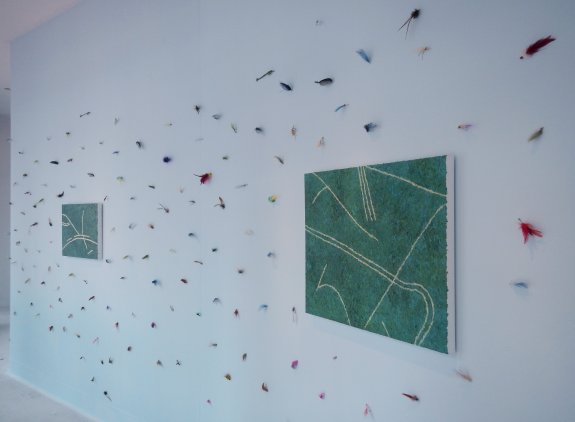
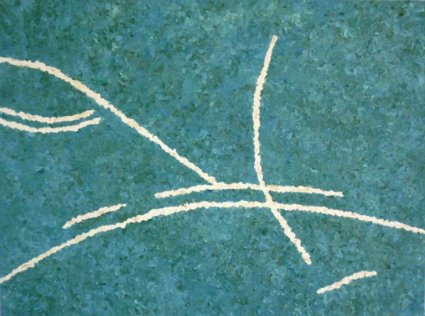
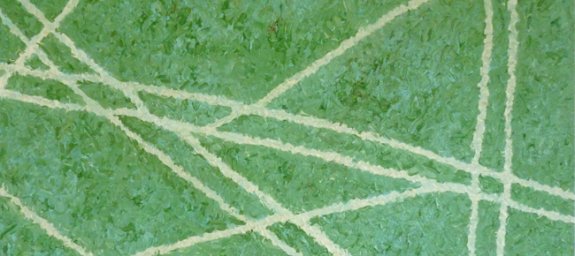
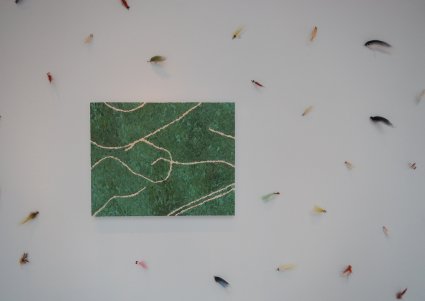
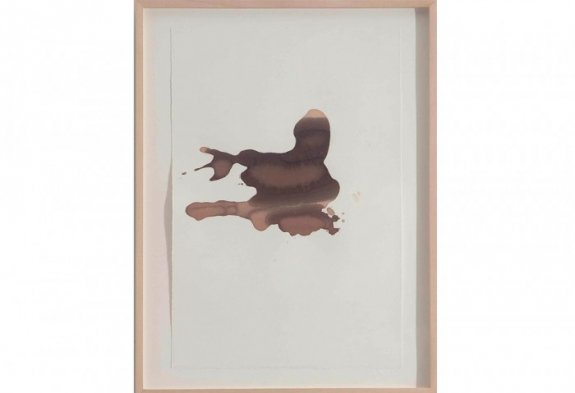
Chris Valdes
Are you from Miami?
Yes. My parents lived in New York but I was born in
Newark, New Jersey for some reason. I came to Miami when I was really young and
have been living here my whole life so yes I would say I am from Miami.
What do you love most about Miami?
What I like about Miami is that it is a young city,
with art and everything else. It is very up and coming. Other cities are more
established because they have a rich history and they have been around for a
while, like New York or Chicago. Miami is up and coming. We can do something to
put this city on the map and I want to be part of that.
When did you start your career as an artist?
I have been painting since I was a little kid. My dad
was an artist, he did mechanical drafting, and my brother was a graffiti
artist. A few years ago I took it into the career direction. I started to rush
less. Now, I take time and leave things to dry and I plan things and put more
effort into it than I would before. The older I got the more I realized that I
have to stop messing around and really focus on my artwork.
What movie should everyone watch at least once and
why?
I am a horror movie guy. I like the original thing.
The old thing. A lot of the horror stuff is pure gruesome and you see stuff cut and
bleed. I like stuff like that.
Do you ever use that as an inspiration in your work?
I used to. Not now. Before, I used to paint very
gruesome and weird stuff.. I switched and now I have these weird and sad,
melancholy-type dudes. That is what they call them. I don’t think they are sad.
They have more of a blank stare, a normal stare. In most of my paintings what
stands out most are the eyes. I think, whether a person is happy, sad or
whatever emotion they are going through, they cannot hide it in their eyes.
Even though someone is smiling you can tell they have conflict in their eyes.
You can tell. Eyes tell a lot about people and their stories.
Do you start with the eyes when you paint?
Yes, most of the times I start with the eyes first.
First thing I draw. First thing I paint.
Many of your characters have two different size eyes.
Why?
I don’t like things perfect. Nothing is really
perfect. If you really think about it and you measure yourself, one eye is
always bigger than the other. I take what you learn from true art and true form
and twist it and change it up. I break the rules in my own way.
Some of your characters are recurring in your work,
aren’t they?
They are similar looking. I try to switch things up
and do different things.
Do you create a narrative around each of these
characters or is that irrelevant to your creation process?
It is irrelevant. It is more like a subconscious
thing. Most of the time I am not trying to portray certain things but they do
come out that way. When I paint I go with the flow.
Do you fashion any of your characters after yourself?
I don’t try to but I guess it does come out that way.
I think every artist kind of puts himself in every painting in a way, whether
it is visually or emotionally. They do. I won’t deny it but I do not do it on
purpose.
Who else do you think about or use as inspiration?
I take everything from everyday life to movies, music,
and friends. I just take a little bit of everything and I create stuff.
Do you title your work?
No I don’t. I am horrible with giving names and
titles. I also do not think they need it. I want the work to speak for itself.
I don’t want to call something “Tahitian Sunrise” because the background has
certain colors. Everybody comes up with these fancy names. I am not a big
writer. That is not my strength. I have talents in other areas. I like to
create worlds and characters. Coming up with names is just not my forte. If you buy one of my paintings or one of my
dudes you can call him “Juan” or Carlos or whatever you want to name him.
You paint a lot of dudes. Do you also paint female characters?
I used to draw only women. I got tired because that is
what everyone wanted me to do. Everybody was like, “draw me a pin up girl, draw
me a zombie girl, draw me a mermaid girl.” I got tired of the same requests. I
wanted to do something different. I draw dudes and it is different. A lot of
artists paint a lot of women. I have always drawn these weird little dudes and
I have my own style. I wanted to do something people recognize as mine. My
stuff is morbid and weird and has a different feel to it. I am actually doing
an Audrey Hepburn piece right now though. I have not painted like that in a while
but I can do it. I like testing myself. It is refreshing to do it once in a
while.
Since we have been talking about weird dudes…what are the “Chris Valdes
Top 5 Weird Dudes?”
1. The bad guy from ‘Who Framed Roger Rabbit” Christopher Lloyd aka Judge Doom
2. Christoph Waltz, who was in “Django Unchained”
3. Daniel Day-Lewis who played “The Butcher” in “Gangs of New York.” He
really plays awesome characters. He is such a great actor
4. The dog “Jake” from “Adventure
Time”
5. I am a weird, bizarre character myself
If you could have an exhibition anywhere, where would you want to have
it?
I think Japan. Tokyo. That would probably be awesome.
I think I would do well there and people would like my art. It is a Mecca for
art and weird stuff so that would be cool and different from what everybody
else does.
What is your biggest dream?
If I can do art and live comfortable then I don’t care
if I get rich or famous. If I can do something that I love and still live in a
house and have a family and do art and get by then I would take that any time.
What is the most important lesson your parents ever taught you?
Work hard and be humble. I get that from my dad. I go
with the flow of things, I am humble and I do not let things get to me and I
work very hard.
Are you a perfectionist when it comes to your work?
Yes. I have a vision but it is never going to be as
exact as possible. Even when you think it is exact and a couple of days or
weeks pass and then you are staring at it you start thinking, “Oh I could have
done this or added that.” That is how you learn from it and you keep going and
going. As time goes by you start mastering your craft more and more.
What do people not know about you?
I give you something most people do not know. It is
something a little more personal. I have really bad anxiety. Really bad. Doing
art calms me down. In times of need, when I need to relax, it makes me function
in society. I am just a very anxious person. Only close friends and family know
about that. It is part of me. I am a weird, neurotic, anxious person. A lot of
the emotions and things that I have gone through shows in my art.
You have quite a few tattoos. Did you design any of
them yourself?
No. I love art so much and I love getting pieces by my
friends who are tattoo artists. I love getting my artist friends pieces and
work. I am such a fan of different styles. I love how people create different
things. That inspires me and keeps me going and pushes me to do better and be a
better artist. I do appreciate art. I am not one of those people who do art and
are snobby and do not like other people’s art. I enjoy people’s art and I see
what they can do and I love seeing people create. Even though they may not have
an artistic background or are not very skilled just doing what you feel and
putting yourself out there, showing your emotion, I appreciate that.
So you basically collect art on your body
Yes I collect art on myself
Do you collect art otherwise?
Yes. I have a couple of pieces from my friends at my
house. I love art. I buy art from my friends. I know they work hard and need to
make their money. I am all for it. I know what they go through to create stuff.
I love art and I am always going to love it.
You recently were part of a group show at Viophilia. What was the
experience?
It was awesome. I loved it. It was very diverse with
so many styles and different techniques. I truly enjoyed that. It was a cool
little show. A show like that really shows the art and the creative side of
people. It had a great turnout. It was a lot of fun and I enjoyed it.
You appreciate diversity of technique. Do you want to experiment with
other media?
I am always trying out new things. I always
experiment. I pick up stuff and see what other people try. As artists we learn
and pick up stuff from other people but always try to do our own thing.
Recently I have been using a lot of clear resin. I like to see what I can do
and I like to add it to my wood pieces to give this nice gloss.

The I AM WYNWOOD Project, created by Miami Artist Barbara M de Varona in October, 2012, began as an on-going collection of stylized portraits depicting the personalities and artful contributions of people in the Wynwood Art Community. Today, a social media expansion of the original project is headed by Barbara, Miami Artist Buddah Funk and Amy Arce. Through the use of interactive social media platforms - Instagram, Tumblr, Flickr, Twitter and Facebook - the project seeks to engage the participation of the community itself....
Via the use of the #iamwynwood hashtags, people can share their own Wynwood experience, using social media to involve the whole community... Buddah Funk and Amy Arce have joined me in moderating Twitter, Flickr, Tumblr etc... and in this 'collaborative' way I'm more than happy to return to my drawings and finish what I started, proudly...
What: I AM WYNWOOD ‘Share YOUR Wynwood’ Photo Contest
Where: INSTAGRAM - http://instagram.com/iamwynwoodproject
When: Submission of photographs will be accepted throughout the month of August, and the winning photo(s) will be selected in September. Multiple chances to win.
How to Enter: Send your Wynwood photos to: [email protected] or hashtag your INSTAGRAM uploads with #iamwynwood for a chance to win Limited Edition I AM WYNWOOD TM Gear
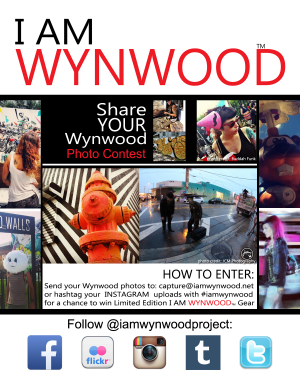
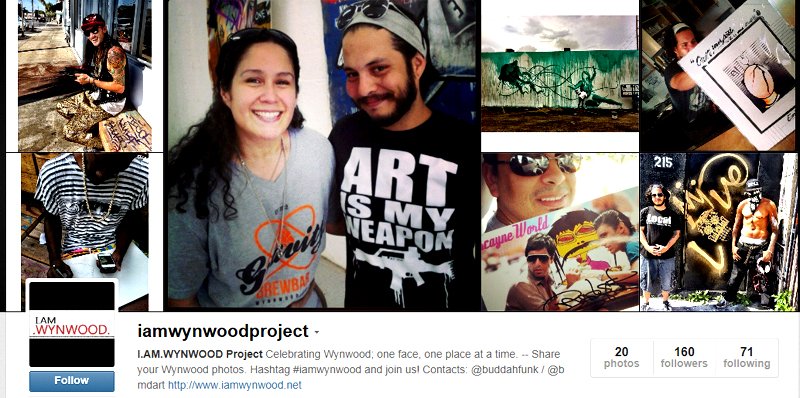
For Art Basel Miami Beach 2012 I decided to create a series of portraits under the unified title “I am Wynwood.” After the first initial 15 portraits I took a bit of a hiatus from the project. There are actually 50 names in the series that I am going to start and finish. I took the hiatus because I wasn’t saying what I wanted to say as loud as I wanted to say it. That is what got me to stop and pause and get to know the community a bit better and in the process made some really good friends and developed a bigger vision. I really wanted for the community to take that statement of “I Am Wynwood,” and internalize it and make it their own and see themselves in it.
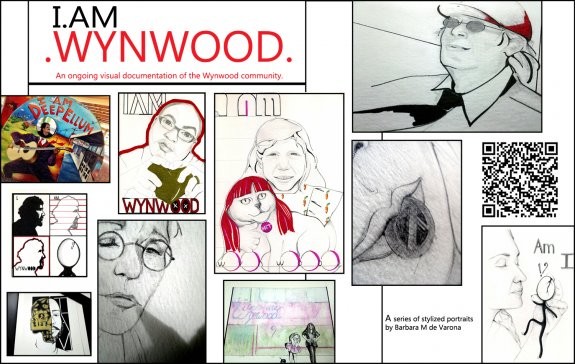
With the help of Buddha Funk and Amy Arce we branched the project out to a social media platform. People can hashtag their photographs and share their Wynwood. So many photographers and people who come through the area focus on the walls, the beautiful murals, which of course are there to be enjoyed but there is more. You go deeper and Wynwood is about community, a sense of belonging. There is an unusual dynamic that, I at least, haven’t found anywhere else. I have an analogy that Wynwood is kind of like a home. It has a very homey feeling. Invariably you run into people the way that you do when you visit your parents and then your cousins show up. Doesn’t this feel like family? I have only been here for three years but when I first got here I just fell in love with the nature of the place.
Through the use of social media we are trying to get everyone, from the person that is serving the beer to the person that is ordering it, to just take that ideal on and embrace it. Sort of the “I love New York” of Wynwood. It is community pride. By hashtagging your photo you join in the collective celebration. We did a little slogan: “ Am Wynwood. Celebrating Wynwood one face, one place at a time.” The concept is that eventually everybody will be sharing their photos and hashtagging.
The reason why we started the contest is that we wanted to get people stoked about saying to themselves “I am Wynwood.” We thought it would be cool to encourage people to share their photographs. Maybe you have some crazy pictures of a night out with your friends or from the last Artwalk and it is a picture of you having a great time. We want you to share it and be part of the “I am Wynwood” project.
